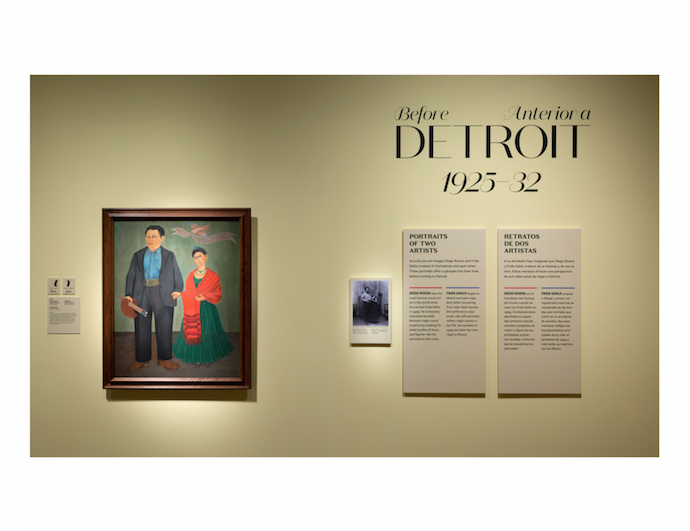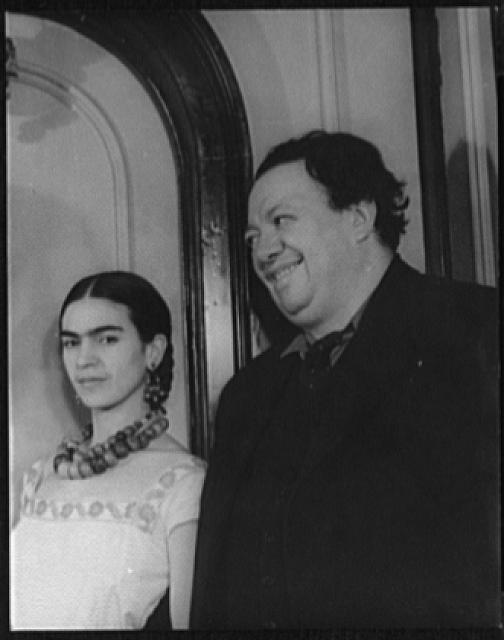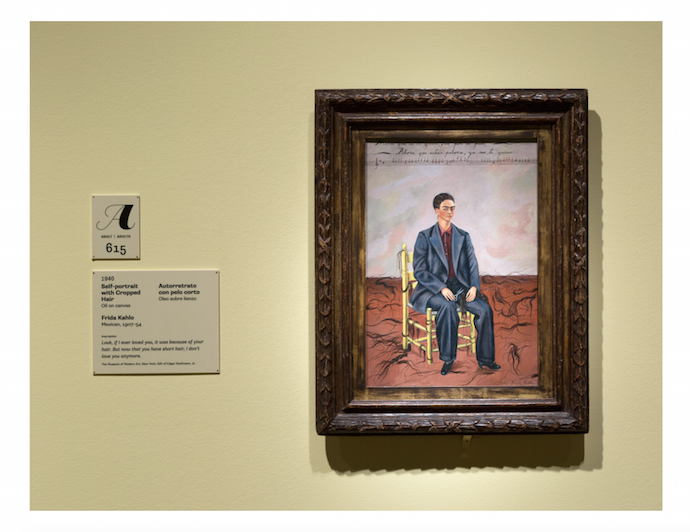“I Dare You”
26.10.15

Courtesy of Detroit Institute of Arts
Dear Frida:
The Detroit Institute of Art features your wedding day portrait in its exhibit of your and Diego’s works. In it your head tilts toward him, as if you’re pointing at him, and your hands are clasped in his. It reminds me of the mountain range that was your love story. Standing before this and your other paintings I understand why I’ve increasingly loved your work for fifteen years.
They’re curious things, the half truths of personas. When I first met you, so to speak, it was as a minor character in Tim Robbins’ Cradle Will Rock, a late ’90s movie that introduced your persona as rude and removed. Later, on a project that required reading every 20th century art section in The New York Times, I learned the French Surrealists helped launch your career. When Salma Hayek played you in Frida, she fleshed out your brilliant, beautiful, charming, and strong light on your early polio, the trolly accident that informed so much of your work, the void of failed pregnancies, and the peaks and valleys of your relationship with Diego. In your diary, written, painted, and drawn entries showed your patriotism for Mexico, admiration for Communism, and the effects of morphine and alcohol addictions.
These are all heavy enough things to consider piecemeal. Decades of your self-portraits put together in the DIA, however, displayed facets of your personality as clearly as the mirrors used to reflect your own face back to you. Hundreds of people come through that exhibit every daily hour. How many of them see themselves in your work like I do?

Image Source: Library of Congress
Black and White Photo, Detroit, 1932
Near the beginning of the exhibit is a black and white photo of you and Diego standing together. Maybe in the DIA or the Scarab Club, where the two of you hung out with other artists while staying in Detroit. The environs seem convivial. His mouth open and smiling, his visual attention elsewhere in the room. Your posture angled toward his, wearing a light colored peasant blouse and likely one of your iconic skirts. While part of you seems loose with the celebration, you’re giving the photographer a look that makes me wonder: Did he approach surreptitiously? Did he try to capture your rare public smile but miss when you turned with catlike reflexes to say with your eyes: “I dare you?”
I remember when I used to have such derring-do, my dear Frida, Friducha. When the awareness of my power as a woman expressed itself as vibrant sexuality, and stilettos and silky Saturday night dresses took center stage in my wardrobe. I don’t bear great looks or a big bosom to throw out like man bait. I am not a Helen of Troy. My gift was the recognition of the inherent power of womanhood. The power that lures sailors to rocky shores.
How to use that power wasn’t as clear. I didn’t opt for fun femininity a la Marilyn Monroe in Diamonds Are a Girl’s Best Friend. Femme fatales like Bette Davis and Barbara Stanwyck were more my style. I wielded that power with arrogance. To me, women had the power to give a thumbs up or down to a man’s come on as if she were a Roman emperor. To give him what he desires or not based on how many hoops he’d jump through and if he executed them properly. I toyed with that line of tension just for kicks. It wasn’t their hearts I was after; it was their surrender.
In all sincerity, this psycho-sexual game likely came in response to ending a six-year relationship that yielded no diamond. I had been relieved to end it but surely there were subconscious ramifications. Maybe my game developed in response to reading Germaine Greer, Camille Paglia, and Betty Friedan. Maybe I was rewriting magazines that tell women how to look and act like a man’s fantasy. Or, considering my family’s generations-strong matriarchy, I’d inherited it. Possibly it happened because my mother’s three marriages before my twelfth birthday had rendered my sexual dynamics askew. Whatever it was, when a graduate writing school friend asked, “Why don’t you ever write about love?” I scoffed.
As an adult, my relations with men were a thrilling game of chess. Studying men’s moves in pursuing that most feminine of assets I matched strategy with strategy. Queen takes pawn and all men were pawns. I dared them to play. I dared them to want me. Then one in particular did.
It didn’t matter how many times I told him, “Go away, little boy,” he remained in pursuit. He didn’t care that I said I wasn’t interested. No was not an option Angelo would accept. Even after the chiseled, strong-willed Italian beat me at my game and succeeded in getting me horizontal, he said, “Call me,” with a sincerity that made me stumble in my stilettos. He dared me to open my heart and did not stop until my armor fell to the floor.
Nude with Beads, 1930
Along the exhibit path comes one of Diego’s lithographs. On thick sepia-toned paper, he’s drawn a woman so clearly we can almost smell the Mexican dust and summer sweat on her light brown skin. She sits at the edge of a bed, nude except for a double strand of large beads around her neck and pumps on her tiny feet. Diego emphasizes not her nudity but her grace. The lithograph’s subject is you. My mind returns to Frida‘s first tender scene between the two of you. You are about to consummate what will become the marriage of a dove and an elephant. As momentum builds you halt, as women often do before baring ourselves to another for the first time.
“I have a scar,” you whisper. You stand up at the foot of the bed, your eyes sweet as a doe’s.
Diego, equally gentle, looks up at you from the bed. “Let me see.” When you show a massive scar on your hip, he doesn’t see it for the grotesque thing you think it is. Instead he says, “You’re beautiful.”
So deftly done, the scene may have been built around this lithograph. It reminds me of an earlier scene of forewarning. In it you and Diego’s ex-wife, Lupe Maria, have just met at a party of artists and revolutionaries. Diego is the life of the party—at least among the women. “They’re like clay in his hands,” Lupe Maria says. “It’s the way he looks at you and finds beauty in all your imperfections. It’s irresistible.”
Who wouldn’t fall in love if someone saw us that way? Isn’t that what we want from a significant other— to be seen as beautiful inside and out? Aren’t the tender things a lover says to us, the light they see us in, part of why we fall in love?
That lithograph tears through cobwebbed memories of Angelo. One night he informed me of my nickname: The Black Widow. The Black Widow? Was I truly so emasculating, a poisonous spider who kills the male after mating? Looking at the man who, despite being my same height of five foot six, seemed like a giant to me, I asked if he also thought I was poisonous. His golden brown eyes lit up when he chuckled, giving me his laughter, which, more than a decade later, remains the most beautiful sound I’ve ever heard.
He later called my bluff again. I had told him months before that I’d moved from Chicago to Florida partly to overcome my aquaphobia. On an October Sunday afternoon we jumped off his father’s boat and he, without warning, said it was time to face it.
“Get in.” He said, preparing his own snorkeling gear. Then the ever-impatient man went under. He floated on the surface of the water. Could I ever muster that kind of grace?
I put on a mask, sucked it against my skin so tight my lips bulged out, hands and knees shaking as I got thigh deep in the water. I held the snorkel straight up, not trusting it to do its job. Then Angelo surfaced and looked straight at me through his mask. “Get in!”
I lowered myself, shaky, slowly, until my open eyes saw below the surface. I spent several minutes adjusting to breathing in and out. Then I scooted myself along the sandy gulf floor with one hand, my other hand hoisting that snorkel like an antenna in search of oxygen. Sunbeams through the water brought a smile to my lips as if they lit the path out of my fear. Forgetting to hold the snorkel, I thrust myself toward Angelo, swimming with both hands. There he was, playfully chasing gold and green fish around, sending them skittering toward me, and I burst into laughter. Bubbles fizzed up my face and made me squeal, such a funny sound from beneath the water. Then, he grabbed my hand and showed me a new world and a strength I can never lose.
That night someone took our photo. My head tilted toward his. My hand clasped within his, smile big and feminine. A picture of a woman surrendered to love.

Courtesy of Detroit Institute of Arts
Self Portrait with Cropped Hair, 1940
The brilliant blue background in Self Portrait with Cropped Hair appears more metaphorical in person than it does online or in expensive coffee table art books. You’re sitting in a room decorated with Gulf blue walls. Wearing one of Diego’s suits that tents you like daddy’s workshirt on a kid. Your expression does not show emulation or adoration, though. Black-brown tendrils are strewn about the floor like an aftermath. But you’ve brushed back your ragged new hair into a man’s sleek style. Sitting in a simple chair, you stare out from the canvas on which you wrote:
“Mira que si te quise, fué por el pelo,
Ahora que estás pelona, ya no te quiero.”
“Look, if I loved you at all it was for your hair.
Now that you’re without hair, I don’t want you anymore.”
Seeing this self-reflection in person, I see those locks of hair as the embers of a fiery marriage after Diego’s wandering eye found its way to your sister and you left him. I’d focused, confounded for years, on the fact that you could relinquish this weapon of feminine power. Long hair is a simple weapon, one a man does not defend himself against. A little click of the barrette releases a whoosh of hair and from across the table he leans forward, fails to suppress a grunt, and stares at you. He wants that hair splayed out on his bed, or tickling his horizontal body from above, or wrapped in his fingers. It is the soft magnet to his hard maleness.
Chopping it off meant transformation. You deflected male attention by butchering away all that long, luxurious hair and adopting masculine clothing like a form of self-protection. “I dare you,” I can almost hear you say, “to find my vulnerability now.”
We both knew from the beginning that Angelo and Diego would be unfaithful. You caught Diego time and again. In Detroit, you watched over him from your high-rise hotel room facing the museum, where he spent long hours every day working on commissioned murals. You knew you weren’t going to stop his wandering eye, that you couldn’t always catch him in the act, yet you stayed with him. Why?
A woman has a moral obligation to leave a cheating husband, I once heard a man argue. Such a nonchalant blanket statement clearly demonstrated he had no experience in such matters. During my femme fatale days though I, who hadn’t yet knowingly experienced being cheated on, had once made an equally bogus, seemingly contradictory argument like some 1950s housewife: Men cheat; that’s what they do. Get over it. Then Angelo did something that changed my tune.
We’d had an open relationship, like yours with Diego. But you know what it’s like when he sleeps with the wrong person, the one person you didn’t think you needed to write a rule about in this silly game of sexual roulette—in your case, Friducha, it was your sister; in my case, it was the girlfriend of Angelo’s best friend.
Crikey, what pain infidelity. Like a sting from a scorpion or a black widow. You just want to eradicate it, lop it off like hair once used as a charm. Or was wearing men’s clothing, such as in this painting, retaliation for you? It was for me. A year after Angelo’s actions, the pain hadn’t yet dried up so I costumed the parts of my gender that felt like exposed nerves, steered my identity compass toward Masculine, and tried to appear the aggressor rather than the prey. I did what many women scorned in love threaten to do: went to the other side. I embraced women. It wasn’t entirely new for me. I’m bisexual, after all.
My new favorite outfit became a pale yellow ascot, a creamy white vest, and Katharine Hepburn-style trousers. I pinned up my hair tightly, though the stilettos did not come off. Women flocked to this form of androgyny, for reasons still beyond my grasp. Experimentation? One friend, a blond French interior designer who’d never so much as kissed a girl, asked one night if she could come home with me. She seductively sucked my fingers as I drove us to my place. She used one hand to do things that made driving difficult. She stayed until morning. Another woman began talking babies and weddings less than half hour into our first date. Another one, a lesbian, expressed more tenderness than I could reciprocate. I shagged enough women that year to make a frat boy envious.
The mornings hurt, though. Hungover, naked, needing a shower, anger took root. Shagging women with no desire for a relationship made my actions feel predatory. The ascot came off. The slacks slipped toward the back of the closet behind soft dresses. Red and black changed to pink and white. All of these things happened a decade ago. Plenty of time to let the scar tissue become defense mechanisms that protect the vulnerable spots Angelo exposed. Men have threatened to break down a wall or two but the fortress prevails. Today these thoughts carom against the memory of my friend asking, “Why don’t you write about love?”
What a habit it has become to say, “Love? Who cares about my love life?” I care. Loneliness feels palpable enough to be named. I fear my inability to really connect with another man, but I’ve spent a decade of doggie paddling in shallow relationships since Angelo, so isn’t it time to grow out the hair again, put on a new dress, and look beyond the scars? To just get over it? So here I am, Frida, writing about love inspired by your reflections on it. I can just imagine you pressing me on, saying, “Go on. I dare you.”
———————
Nichole L. Reber has won a couple of awards for her nonfiction about art, architecture, travel, and cultural politics. She heads a nonfiction writers group in Columbus and writes a PANK column on international literature. Her work has appeared in World Literature Today, The Atticus Review, and EastLit.